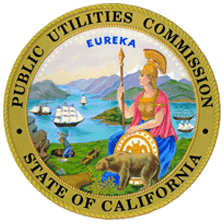





There are many distributed generation interconnection programs offered by the California Investor Owned Utilities (IOUs) which include Pacific Gas and Electric (PG&E), Southern California Edison (SCE), and San Diego Gas & Electric (SDG&E). These programs include but are not limited to net energy metering (NEM) and Net Billing Tariff (NBT) programs.
Electric Rule 21 is a tariff (or set of regulations) that describes the interconnection, operating, and metering requirements for distributed generators that will be connected to a utility’s electric system. Rule 21 governs CPUC-jurisdictional interconnections, which include the interconnection of all net energy metering (NEM) facilities, "Non-Export" facilities, and qualifying facilities intending to sell power to the host utility. Per CPUC direction, data on applicable Rule 21 projects for PG&E, SCE, and SDG&E will be collected and published on an ongoing basis starting in May 2019. For more information regarding Rule 21, please visit each IOU’s respective website below.
Net energy metering, or "NEM", and Net Billing Tariff, or “NBT”, are special billing arrangements that provide credit to customers with distributed generation systems (such as solar PV systems) for the excess electricity their system generates. Under NEM/NBT, the customer's electric meter keeps track of how much electricity is consumed by the customer and how much excess electricity is generated by the system then sent back into the electric utility grid. Per CPUC decision (D.)14-11-001, the CA IOUs started publishing solar PV NEM application data in July 2015. For more information regarding the IOU NEM/NBT programs please visit each IOU's respective website below.
The RES-BCT program (formerly AB 2466) was established by the legislature effective January 1, 2009, and is codified in Section 2830 of the Public Utilities Code. It allows a Local Government with one or more eligible renewable generating facilities to export energy to the grid and receive generation credits to benefitting accounts of the same Local Government (AB 1031 expanded applicability to universities). AB 512, signed into law in 2011 and effective on January 1, 2012, further modified this program to increase the generator size limit to 5 MW per generation account. For monthly data about progress made toward the RES-BCT cap, please visit each IOU’s respective websites below.
Since 1998, California has supported distributed generation technologies such as solar photovoltaics, solar hot water, wind, batteries, fuel cells, biogas and more through a variety of incentive programs, including the Emerging Renewables Program and later the Self-Generation Incentive Program. In 2006, the California Solar Initiative was created by Senate Bill 1 with a total budget of $2.167 billion and a goal to install approximately 1,940 MW of new solar generation capacity between 2007 and 2016. The CSI program, implemented by various program administrators and overseen by the CPUC, has many components: a general market solar incentive program, low income solar incentive programs, a new solar homes program, and a solar thermal incentive program. All of these programs are covered in more depth below.
Filter by:
The Solar on Multifamily Affordable Housing (SOMAH) program provides up to $100 million annually in financial incentives for installing photovoltaic (PV) energy systems on multifamily affordable housing in California. The program’s unique, community-based approach ensures long-term, direct economic benefits for low-income households, helps catalyze the market or solar on multifamily housing and creates jobs. SOMAH is funded through the greenhouse gas allowance auction proceeds of Pacific Gas and Electric Company, San Diego Gas & Electric Company, Southern California Edison Company, Liberty Utilities Company and PacifiCorp. SOMAH aims to install 300 megawatts of generating capacity by 2032.
The CSI General Market program aimed to incentivize 1,750 MW of market rate solar in IOU territories by 2017 with an incentive budget of $1.947 billion dollars. Data from the California Solar Initiative had previously been publicly available on the California Solar Statistics website, but retired on June 1, 2020. This data is available on California DGStats, including archived charts, tables, budget reports and data annex files below. The program was overseen by the CPUC and was administered by PG&E, SCE and CSE (in SDG&E territory).
A component of the California Solar Initiative included providing residential and non-residential incentives for electric, natural gas, or propane-displacing solar hot water heating systems. The CSI Thermal program had a budget of $250 million to promote the installation of 200,000 solar thermal systems in homes and businesses by 2017. The program was overseen by the CPUC and was administered by PG&E, SCE and CSE (in SDG&E territory).
In 2006, the Legislature passed Assembly Bill (AB) 2723 requiring the Commission to ensure that not less than 10% of overall CSI funds be used for installing solar PV on low-income properties. The MASH program was established in 2008 with $108 million in funding to provide incentives for solar PV systems on qualifying, multi-family affordable housing properties. In 2013, the Legislature passed AB 217, which extended the MASH and SASH programs and authorized a total of $108 million of additional funding across both programs. The CPUC allocated $54 million in funding for the MASH program and established a goal of installing an additional 35 megawatts (MW) on multi-family affordable housing by 2021.The MASH program was overseen by the CPUC and was administered by PG&E, SCE and CSE (in SDG&E territory). The MASH program stopped accepting new applications in 2022 and sunsetted in 2023. The MASH virtual net energy metering tariff remains open for future customers even though they are not MASH program participants.
In 2006, the Legislature passed Assembly Bill (AB) 2723 requiring the CPUC to ensure that not less than 10% of CSI funds be used for installing solar PV on low-income residential housing. The SASH program was established in 2007 with $108 million in funding to provide incentives for solar PV systems on existing owner-occupied low-income households. In 2013 the Legislature passed AB 217 which extended the MASH and SASH programs and authorized a total of $108 million in additional funding across both programs. The CPUC allocated $54 million in funding for the SASH program and established a goal of installing 15 megawatts (MW) on low income single family homes by 2021. The SASH program was overseen by the CPUC and was administered by GRID Alternatives. The SASH program stopped accepting incentive reservations in 2021 and sunset in 2022, replaced by the DAC-SASH program moving forward. See here to see if you qualify for the newer DAC-SASH program.
The CPUC voted in September 2019 to approve the Disadvantaged Communities - Single-family Solar Homes (DAC-SASH) Program Handbook, with Resolution E-5020, signaling the official launch of the program. The statewide program provides $8.5 million annually in incentives to help homeowners in disadvantaged communities (DACs) go solar by reducing the cost for qualifying households. To qualify, homeowners must live in a DAC, which for the purposes of the DAC-SASH program is defined as a community that is identified by using the CalEnviroScreen (CES) 3.0 as among the top 25% disadvantaged census tracts statewide or 22 census tracts in the highest 5% of CES’s Pollution Burden that do not have an overall CES score because of unreliable socioeconomic or health data. In 2020, the CPUC expanded the program’s definition of DAC to include California Indian Country. The percentage of census tracts that are DACs and therefore eligible for the DAC-SASH program are as follows: 5% of SDG&E territory are CES DACs, 15% of PG&E territory, and 29% of SCE territory. Homeowners must also meet income qualifications denoted by annual California Alternate Rates for Energy Program (CARE) and Family Electric Rate Assistance Program (FERA) guidelines. The program is overseen by the CPUC and administered by GRID Alternatives.
Photo Credit: David Cuetter
The New Solar Homes Partnership (NSHP) is part of the CSI program and has a goal to install 360 MW of solar on new homes. NSHP provides financial incentives and other support to home builders, encouraging the construction of new, energy efficient solar homes. The NSHP program is overseen by the CPUC and currently administered by the California Energy Commission.
In 2001 the Self-Generation Incentive Program (SGIP) was created to provide financial incentives to support existing, new, and emerging distributed energy resources that are installed to meet all or a portion of the electric energy needs of a facility. Qualifying technologies include wind turbines, waste heat to power technologies, pressure reduction turbines, internal combustion engines, microturbines, gas turbines, fuel cells, and advanced energy storage systems. Please note that prior to 2007 SGIP provided incentives for solar PV systems larger than 30kW. The program is overseen by the CPUC and administered by PG&E, SCE, Southern California Gas Company (SCG) and CSE (in SDG&E territory).
Starting in 1998, the Emerging Renewables Program (ERP) began incentivizing PV systems (in addition to other renewable energy systems) under 30 kW. ERP stopped incentivizing solar PV systems in 2007 when the California Solar Initiative launched. On June 27th, 2012 the ERP closed and stopped accepting applications. The program was administered by the California Energy Commission.
In addition to the creation of the California Solar Initiative, SB-1 also required California’s publicly owned utilities (POUs) to create a solar incentive program by January 1, 2008. Collectively, the publicly owned utility solar incentive programs will use $700 million to install 784 MW of solar installations. The program is overseen by the CEC and administered by the respective POUs.





